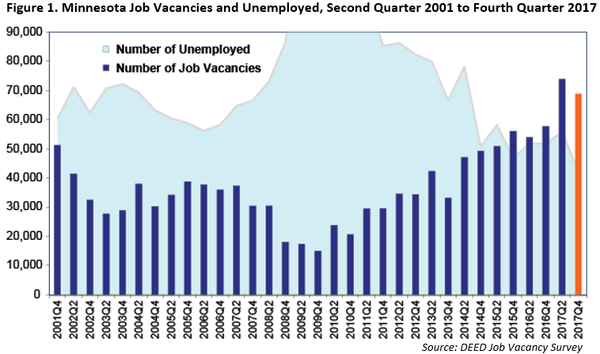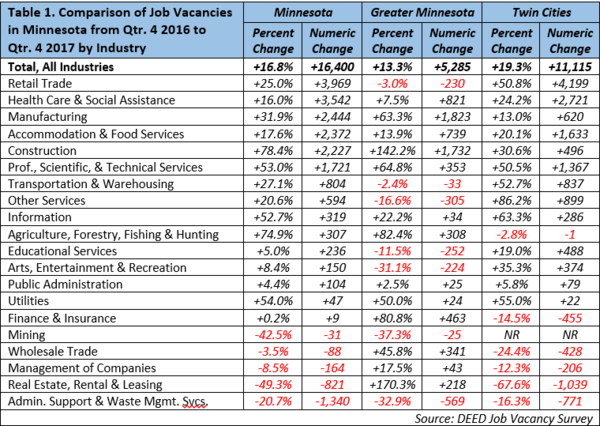TAA Updates
- Newly certified petitions:
-93613 Zareba Systems—Ellendale, MN
-93560 Nilfisk—Brooklyn Park, MN
-93621 DaVita Clinical Research—Minneapolis, MN
-93637 Optum Operations/Population Health
Management Division-Eden Prairie, MN
-93262E Boyd Coffee—Eagan, MN
- Petitions with investigation in process
-93735 Hutchinson Technology Inc—Hutchinson, MN
-93704 Electrolux Major Appliances-Freezer
Division—St Cloud, MN
-93692 Quantum Spatial—Maple Grove, MN
-93655 Allete—Cohasset, MN
-93628 Northstar Aerospace—Duluth, MN
-93475 Vyaire—Plymouth, MN
TAA Needs to Update our Counselor Contact List
TAA would like all providers to send us (deed.taa@state.mn.us)complete lists of
Dislocated Worker counselors, support staff to the DW program, and supervisory
staff for all locations within the state of Minnesota. There have been a lot of
changes in the last year with people changing jobs, retiring etc.
Serving TAA Clients
Of late, many TAA eligible participants attempting to be
enrolled in the Dislocated Worker Program, are being turned away from provider
locations both free standing and WorkForce Centers. These would-be participants
are being told a number of things (no funding, go directly to TAA, we don’t do
TAA).
TAA’s response to this is
- Everyone should
still be entitled to core services and TAA does have training funding as well
as other benefits. The only thing the participant would not have access to is
support funding. TAA eligibility supersedes the provider’s budgetary concerns.
- Minnesota policy
is that TAA participants must be co-enrolled in the Dislocated Worker Program.
Enrollment in the DW program first is imperative. TAA participants have tight
timelines so WorkForce Centers and others need to accommodate the participant
by enrolling them promptly.
- If your front
desk personnel do not know what TAA is, TAA is happy to provide training.
- If you have a
Dislocated Worker Counselor on staff, he/she must work with the TAA eligible
participant. If that staff member is unfamiliar with the TAA program, TAA can
work with them every step of the way.
Thank you for the work you do! We are all here to work
together to provide Minnesotans with the skills needed to find new employment.
Grants and Policy Update
Waiver Requests for Formula Funds
As you plan for
SFY19, one option available to you is a carry-in waiver in order to
carry-forward more than 20% of your PY17/FY18 funds in PY18/FY19. As a
reminder, providers are required to spend or obligate at least 80% of their
current year allocation by June 30 each year in order to avoid recapture of the
excess funds. 20 CFR 683.140 states, “For the youth, adult and dislocated
worker programs, the amount to be recaptured from each local area for purposes
of reallocation, if any, must be based on the amount by which the prior year's unobligated balance of allocated funds exceeds
20 percent of that year's allocation for the program, less any amount reserved
(up to 10 percent) for the costs of administration. Unobligated balances must be determined based
on allocations adjusted for any allowable transfer between funding streams. The
amount to be recaptured, if any, must be separately determined for each funding
stream. The term “obligation” is defined at 2 CFR
200.71.” This applies for State Dislocated Worker formula grants as well.
The final June financial status report/reimbursement payment request, due by
August 15th for the Adult and Dislocated Worker programs, will be used to
determine the remaining unexpended balance to be recaptured.
If you do not
request a waiver, or if your waiver is denied, DEED will begin the process of
recapturing funds after August 15, 2018. If funds are recaptured from your
existing grant, DEED will request that you submit a grant modification in order
to decrease the overall grant amount and realign cost categories. Only
providers who have met the 80% obligation requirement for the PY17/FY18 funds
will be considered to receive redistributed funding, if any becomes available.
If you elect to receive reallocated funds, DEED will also request that you
submit a grant modification in order to increase the overall grant amount and
adjust cost categories, if necessary.
Beginning this year, we are requesting that any provider
who may be interested in submitting a carry-in waiver for next fiscal year
participate in a conference call (or in-person meeting, if preferable) with DW
staff to talk about your needs, the anticipated amount of the waiver, how this
impacts your planning and to answer any questions you may have about the
process. DEED will create a form to facilitate waiver requests. Please
contact Monica Weber (monica.weber@state.mn.us)
if you are anticipating needing a waiver to carry-in excess funding and to set
up a brief call with our team. Some things we’d like to address during the call
include:
- Reasons for request
- Impact on cost categories in
PY18
- Impact on workers if the
request is not approved, and
- Other relevant contributing
factors
Switching
Participant Activity Funding
As we get to the end of the
fiscal year and as mass layoff grants close, please remember to change all the
participants’ activities in Workforce 1 to reflect the correct funding stream.
For example, if you have a mass layoff grant ending on 6/30/2018, and the
participant is rolling into your formula, close all activities relating to the
mass layoff funding and open the new funding stream (i.e. State DW). You do not
need to exit the participant and reenroll them. Please let us know if you have
questions on this process.
Performance Updates
New PIRL Edit Checks:
Immediate corrective action required
Under WIOA Law it
is required that every participant have an active Individualized Employment
Plan (IEP) on record. This requirement is tracked within the quarter and annual
federal reports DEED submits to the Department of Labor called the WIOA
Participant Individual Record layout (PIRL).
The PIRL edit check
requires every WIOA Adult (AD), Dislocated Worker (DW), and Trade Adjustment
Assistance (TAA) program participants have an IEP on record with a date no
later than the first day of training. To us in Minnesota this means, every
participant enrolled in the AD, DW, and/or TAA programs must have a “Plan”
captured in Workforce One (WF1) with a “Confirmation Date” prior to the
earliest training activity start date.
During the PIRL
test run for quarter ending March 31, 2018 it was brought to our attention that
many DW, AD, and TAA participant records did not have a plan captured on their
case. Since this is a requirement under federal law, we must have this data
entered immediately. We ask that you review all of your cases as soon as
possible and have all over your participant’s plan captured in WF1 by COB
May 7, 2018.
Steps to capture
IEP dates in WF1
- Log into your WF1 account
- Hover over “Search” within the top panel and select “Person”
- Enter the participant’s details and click “Run Search”
- Select the correct participant record by clicking on their name.
- Once in the case record, click on “Plan” within the side panel.
- You have the option to create an online plan or capture the dates within
your paper plan
- Both plan options require three dates be entered into the system
o Start Date: MUST be prior to
the earliest dated training activity (WIOA law)
o Review Date: auto-populated with a date 1 year from the start date
(policy requires plan reviews at least once per year)
o Confirmation Date: MUST be
prior to the earliest dated training activity (WIOA law)
- Click "Save and Activate"
Please contact our
Performance and Data Coordinator, Amy Carlson, at amy.carlson@state.mn.us with questions or concerns you may have on this data requirement.

Known glitch in the Measurable Skills Gain (MSG) indicator calculation
Currently the
Department of Labor (DOL) is looking for at least one MSG per year on all
participant records who were enrolled in training at any time during their
program enrollment instead of only participants who were enrolled in training
during the reporting program year. DEED alerted the DOL to this problem
as soon as it was discovered. The DOL has confirmed this is on their radar
and expect to implement a new version of the PIRL and its reporting
specifications in PY 2018, which should address this issue.
Amy Carlson will
continue to update you on this situation as more information is received.
Secondary Exit Reason updates Highly Recommended
Under WIA law an
allowable exit reason that would exclude participant records from performance
outcomes was “Health/Family Care”. Under WIOA law there is a similar
exclusionary reason of “Medical Treatment”. Since the new exit reason was not
mapped to WF1 until March 31, 2017, there are many participant records rolling
into WIOA performance cohorts who were exited to “Health/Family Care” but
instead of being excluded, they are in the performance indicator calculations.
Again, this is due to that exit reason no longer being an allowable exclusion
under WIOA.
Since some of the
participants who exited to “Health/Family Care” may have truly exited due to
“Medical Treatment” it is highly recommended that you run a WF1 exit report on
all your participants who exited between 07/01/2016 – 03/30/2017. After you run
the exit report, you should investigate each record with the exit reason of
“Health/Family Care” to determine which ones should be switched to the new
exclusionary reason. (Directions to do this are provided below)
Should you have any
questions or concerns, please contact Amy Carlson at amy.carlson@state.mn.us for additional guidance.
Step One: Run an
Exit Report in WF1
1. Log into your WF1 account
2. Click on “Reports” within the top panel and select
3. Scroll down the list of available reports and select “Exit Detail Report”
- Select “COFFR level” as the Scope
- Select “Funding Stream Category level” as the Funding
- Click “Next”
4. Select your WDA as the COFFR
5. Select the program in which you want data; Remember to investigate all
participant records who exited any WIOA funded program as well as the State
Dislocated Worker program. You can do each program separately or slick on
“Select/Deselect” to choose multiple programs at the same time.
6. Select “Exit” Date Type
- Enter 07/01/2016 as the Exit Start Date
- Enter 03/30/2017 as the Exit Start Date
7. Select “Health/Family Care” as the Exit Reason
8. Click “Run Report”
9. Click on the icon that looks like a floppy disk and select the type of
report you want WF1 to generate. (CSV is the easiest to work with as long as
you change the file type to Excel when saving)
Step Two: Read
through case notes
1. Hover over “Search” on the top panel and select “Person”
2. Enter the “Record ID” listed on the report into the “Record ID” field
3. Click “Run Search”
4. Click on the participant’s name to go into their record
5. Click on “Case Note Search” within the side panel
6. Read the most recent case notes to determine if the participant was
exited to Medical Treatment (needs to be their own medical treatment not a
family member’s treatment)
7. If the participant was exited due to a medical treatment that would have
prevented them from continuing in the program for more than 90 days, make note
of the case note date and move on to step three.
Step Three: Enter a
secondary exit reason
1. While still in the case record, click on “Follow-Up” within the side
panel
2. Click on “Add” within the Action column
3. Enter the case note date or the exit date (whichever is later) as the
“Contact Date”
4. Select the “Medical Treatment” as the Secondary Exit Reason
5. Select “No” for Employed
6. Select “No” for Obtained Supplemental Wage Verification
7. Enter a case note explaining the situation: Here is a sample case note
you can use
“Due to the change of exclusionary exit
reasons under WIOA law and the newly defined exit reason in WF1 applied on
March 31, 2017 this case record was updated with a secondary exit reason. Prior
to entering this secondary exit reason, case notes did confirm this update was
required in order to accurately capture the participant’s situation.”
8. Click “Save” and move on to the next record listed on your report
Seeking Success Stories
The WIF (Workforce Innovation
Fund) project team is seeking participant success stories for the TAA and
Dislocated Worker programs. These stories will be featured on the new
CareerForce platform that launches on 9/30/2018. The stories may be
accompanied by videos or pictures and the WIF project can help make
arrangements (photographer, videographer) and provide appropriate media consent
form(s). Please review your participant caseload for candidates with
great stories to share. Their positive and often life changing outcomes
will be inspiring.
If you have questions – please email:
Jill Moe – Project Manager at
jill.moe@state.mn.us
or
Linda Skogen – Project
Coordinator at linda.skogen@state.mn.us
 Corner On The Market
With Cameron Macht
Regional Analysis & Outreach Manager
Minnesota Dept. of Employment & Economic Development
cameron.macht@state.mn.us
320-441-6596
Employers reported a total of 113,774 job vacancies
in the fourth quarter of 2017, the second highest number on record and a clear
demonstration of the continuing strength of Minnesota’s economy. With so many
employers expanding and that many jobs available, the number of unemployed workers has
been dropping, to an average of about 88,000 people at the end of 2017.
At those levels, Minnesota now has the lowest jobseeker-to-vacancy
ratio on record, with just 0.8 jobseekers per vacancy (see Figure 1). Employers
are struggling with the tight labor market and are looking for new ways to
attract and retain talented workers.
|
 Statewide, the Health Care & Social Assistance industry had the
most job vacancies with just over 25,500 openings, followed by Retail Trade
with about 20,000 postings, Accommodation & Food Services with 16,000, and
Manufacturing with 10,105 job vacancies. Regionally, 68,854 (or 60.5%) of all
job vacancies were located in the seven-county Twin Cities metro area, while
the remaining 44,919 vacancies (39.5%) were located in Greater Minnesota.
Compared to one year prior, the number of job vacancies increased by
19.3 percent in the Twin Cities and 13.3 percent in Greater Minnesota. But
different industries were seeing different levels of demand in different
regions. For example, the number of openings in retail trade actually declined
in Greater Minnesota, but jumped over 50 percent in the Twin Cities. Employers
in the Twin Cities were also hoping to hire more workers in health care and
social assistance, accommodation and food services, professional and technical
services, transportation and warehousing, and other services.
In contrast, the number of job vacancies in both manufacturing and
construction expanded nearly 5 times faster in Greater Minnesota than in the
Twin Cities. Greater Minnesota was also seeing growth in demand for workers in
agriculture, finance and insurance, wholesale trade, and real estate, rental
and leasing, while the Twin Cities was seeing declines (see Table 1).

Success Story
Jim, Minnesota Valley Action Council (Mankato)
Jim enrolled in the Dislocated Worker Program after being
laid off from his employment of over 20 years. Jim had advanced through the
ranks to Welding Supervisor, without formal training.
Jim was referred to Minnesota Valley Action Council for
career counseling and linkage to the training needed to achieve his employment
goal. After reviewing his assessment results, Jim knew exactly what he wanted –
a welding certificate to prove he has the knowledge and skill to be a
successful welder.
Jim enrolled at South Central College, but faced a
setback, the North Mankato welding classes were full and he would have to
travel to Faribault. With only 3 days until training started there was no time
to pursue another option so Jim started making the trip 102 miles round trip.
One blown head gasket, 4 motor mounts, and over 6000 miles later, Jim completed
his training.
His reputation as a hard working student and exceptional
welder helped him land a job immediately. He completed his training on a Friday
and started employment on Monday.
Jim is grateful for the opportunity to get training so he
could get back to work immediately.
UNIT DIRECTORY
May Thao Schuck, Interim
Director, 651-259-7563
Dislocated Worker General Information, 651-259-7537
Rapid Response
Marla Beaty (TAA Liaison), 218-259-1380
Mo Malin, 651-259-7535
Liz McLoone (Labor Liaison), 651-259-7145
Jason Wadell, 651-259-7552
Mee Yang, 651-259-7548
Grants
Chelsea Georgesen, Dislocated Worker and Federal Adult Programs Supervisor,
651-259-7508
Monica Weber, 651-259-7560
Amy Carlson (Performance), 651-259-7542
TAA
General
TAA Contact, 651-259-7543 or 888-234-1330
Sarah Saito, TAA Supervisor, 651-259-7546
Cindy Boyle, TAA Coordinator, 651-259-7551
Jennifer Anderson, 651-259-7690
Mary Garcia, 651-259-7553
Laurie Larson, 651-259-7681
Thomas Sommer, 651-259-7585
Jackie Umlauf, 218-739-7560
Olajide Williams, 651-259-7431
Trade
Readjustment Allowance, 651-296-3644 or 877-898-9090 (ask for
TRA Specialist)
We want this e-Newsletter to meet your needs! We encourage you to send your comments and suggestions to Liz.McLoone@state.mn.us,
Find past issues of Partner's Express here.
Wanting to subscribe to this newsletter? Contact Liz McLoone at Liz.McLoone@state.mn.us with your request!
|